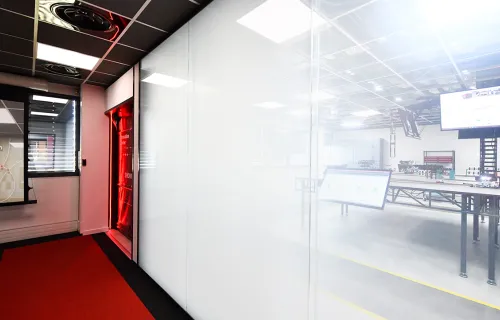Heavily impacted by the pandemic, manufacturers are on the road to recovery. Markets are showing signs of stabilizing again and demand is nearly back to pre-pandemic levels or even higher in some cases.
Has the pandemic accelerated the digital transformation in manufacturing industries? According to the 2021 Voice of Our Clients, 15% of manufacturing executives say they are producing results from digitization strategies, up 2% from last year. This has doubled compared to previous years, where year-over-year progress was at 1%; however, overall progress remains at a very low level.
Despite this slower progress, executives have increased focus on progressing their digital strategy. The understanding of the importance of having a digital strategy and its impact on existing business models increased by 13%, while the pressure felt from consumers to become more digital increased significantly in the year of the pandemic (+14%). Although manufacturers’ main focus continues to be on optimizing operations to save costs, this increased focus on their digital strategy to satisfy consumers will accelerate their digitization journey.
Yet, they face a new challenge—one that is becoming increasingly important: Achieving true sustainability and becoming climate neutral.
If it’s good for the environment, can it also be good for business?
With business results highly impacted by the pandemic and high digitization costs, the additional cost to become green can seem like an impossible burden. Can sustainability be put on the back burner? The answer is straightforward: no, sustainability is non-negotiable. It’s a complex journey and it’s urgent for a number of reasons.
Pressure from stakeholders is mounting. There are stringent governmental compliance regulations to be met and higher expectations of transparency and accountability from customers and communities. Moreover, investors are increasingly looking to price exposure to climate risk into the cost of capital.
For manufacturers, becoming sustainable has the potential not only to positively impact the ability to secure investment and their bottom line, it’s also pivotal to brand reputation and the future of the planet.
In a nutshell, if it’s good for the environment, it’s good for business.
And manufacturers do care about sustainability. Seventy-one percent of the manufacturers we spoke with strongly believe that environmental sustainability is core to their organization’s ability to continue creating value in the future. This resonates more strongly with natural resources executives (87%) than commercial and industrial sector executives (67%). When comparing the importance of sustainability with all other industries, manufacturers ranks second, only after energy and utilities.
What is sustainable manufacturing?
The Global Reporting Initiative (GRI) guidelines summarize sustainability into three broad areas: society, economy and environment. The U.S. Environmental Protection Agency (EPA) defines sustainable manufacturing as the creation of manufactured products through economically sound processes that minimize negative environmental impacts while conserving energy and natural resources.
In this blog, I explore the environmental aspect in the commercial and industrial, and natural resources manufacturing sectors. Environment sustainability covers an organization’s impacts on living and non-living natural systems, including land, air, water and ecosystems. For manufacturers, this covers a wide gamut of areas: emissions reduction, water consumption, biodiversity protection, responsible sourcing of materials, clean energy and efficiency choices and, disposal, recycling and re-use of effluents and waste.
A practical starting point
Many manufacturers have already publicly announced their climate commitments. A good starting point to realize those commitments is to first understand your carbon footprint and climate-risk exposure. In fact, by 2025, climate-risk assessments will be mandatory for listed companies, large private businesses and the financial services sector. Here are some recommendations to get started:
- Sustainability must be an enterprise-wide undertaking.
-
Make it an agile, top-down initiative that empowers each plant manager and each worker to own and contribute to this initiative. Entrust the enablement and decision-making power to the plant and set up a process to continuously track, report and exchange experiences. Furthermore, make your results visible by continuously communicating even the small successes.
- Alignment between business and IT is key.
-
It is important to define a sustainability roadmap with clear requirements and priorities and ensure that both the business and IT sides are onboard with it.
- Gauge the “as-is” situation.
-
Assess the current production scenario in each plant or product group. The goal is to identify the existing production parameters at the shop floor level that help you measure the environmental impact. For example, track energy consumption both during the production process as well in the plant to calculate the CO2 baseline.
- Technology is a key enabler.
-
Develop a sustainable IT roadmap that includes a clear strategy and structure to address your organization’s challenges and ambitions around IT management. The activities of the previous steps will highlight any existing gaps or issues in your current production environment. For example, missing information in critical datasets or unintended breaks in tracking systems that may hinder transparent reporting of your achievements. Sustainability needs to become core to your business, like cybersecurity is now.
- It is a journey of continuous improvement.
-
Establish methodologies and reporting systems to measure and report environmental performance at the plant level and continuously monitor progress. Often, systems that cover all activities and compliance measurements are missing. A governance structure might be required to address this gap. This will help also to manage external parties and suppliers and assess their contributions to your sustainability activities.
- Take advantage of low-hanging fruit.
-
Energy efficiency is one example. Begin by centrally steering decisions related to alternative energy sources and sourcing to ensure that energy is sourced sustainably or re-used.
A strategic growth opportunity
True sustainability is a collaborative effort. It cannot be achieved by a single organization. Every participant and component in your end-to-end value chain has an environmental impact. This includes suppliers, transport modes and technology partners. Working with organizations that share your sustainability goals and values is important. It is equally vital to assess the sustainability credentials and practices of each participant. Together with the right participants, it is possible to create a truly sustainable end product.
However, manufacturing ecosystems are complex. Once you begin to audit the sustainability credentials of your ecosystem, it may become overwhelming. Were the natural resources ethically sourced? How were they transported to the factory? Was the manufacturing process carbon neutral? As things stand, these are difficult questions for any manufacturer to answer. Yet, the business benefits and opportunities are numerous:
- Increased customer loyalty and commitment
- Reduced costs by optimizing processes from sourcing to production to logistics
- Creation of new revenue streams that support sustainable business models
- Identification of new ways to make existing services more sustainable
As the old Chinese proverb goes: A journey of a thousand miles begins with one step. At CGI, we’re here to help you take this first step in your successful sustainability journey. Contact me to learn more about how we’re helping clients achieve their sustainability vision and how we can help you achieve yours.





